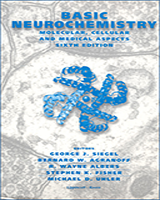By agreement with the publisher, this book is accessible by the search feature, but cannot be browsed.
NCBI Bookshelf. A service of the National Library of Medicine, National Institutes of Health.
Siegel GJ, Agranoff BW, Albers RW, et al., editors. Basic Neurochemistry: Molecular, Cellular and Medical Aspects. 6th edition. Philadelphia: Lippincott-Raven; 1999.

Basic Neurochemistry: Molecular, Cellular and Medical Aspects. 6th edition.
Show detailscAMP serves as an intracellular second messenger for numerous extracellular signals in the nervous system. In fact, the number of functional processes regulated by cAMP is too large to enumerate here in detail. It is important, however, to review the general types of effect that cAMP exerts in neurons.
cAMP can be viewed as subserving two major functions in the nervous system
First, cAMP mediates some short-term aspects of synaptic transmission: some rapid actions of certain neurotransmitters on ion channels that do not involve ligand-gated channels are mediated through cAMP. Second, cAMP, along with other intracellular messengers, plays a central role in mediating other aspects of synaptic transmission: virtually all other effects of neurotransmitters on target neuron functioning, both short-term and long-term, are achieved through intracellular messengers. This includes regulation of the general metabolic state of the target neurons, as well as modulatory effects on neurotransmitter synthesis, storage, release and receptor sensitivity; cytoskeletal organization and structure; and neuronal growth and differentiation. This also includes those long-term actions of neurotransmitters that are mediated through alterations in neuronal gene expression.
It is important to emphasize that such a role for cAMP and other intracellular messengers is not limited to actions of neurotransmitters mediated via G protein-coupled receptors. Thus, although activation of ligand-gated ion channels leads to initial changes in membrane potential independent of intracellular messengers, it also leads to numerous additional, albeit slower, effects that are mediated via intracellular messengers. For example, activation of certain glutamate receptors, which are ligand-gated ion channels, leads rapidly to membrane depolarization and more slowly to increases in cellular levels of cAMP by activation of Ca2+/calmodulin-sensitive forms of adenylyl cyclase. cAMP then mediates several other effects of glutamate on the neurons. By virtue of numerous interactions between cAMP and other intracellular messenger pathways, these pathways play the central role in coordinating a myriad neuronal processes and adjusting neuronal function to environmental cues [43].
Most of the effects of cAMP on cell function are mediated via protein phosphorylation
By far the most important mechanism by which cAMP exerts its myriad physiological effects is through the specific activation of cAMP-dependent protein kinase. This was demonstrated first by Krebs and coworkers for cAMP regulation of glycogenolysis, and shortly thereafter it was shown to be a widespread mechanism by Paul Greengard and his colleagues. Indeed, cAMP-dependent protein kinase is now known to phosphorylate virtually every major class of neural protein; this accounts for the ability of cAMP to influence so many diverse aspects of neuronal function. The ability of cAMP to activate protein kinases and the role of protein phosphorylation in the regulation of neuronal function are covered in greater detail in Chapter 24.
How do a wide variety of neurotransmitters and hormones produce tissue- and cell-specific biological responses if many such responses are mediated by the same intracellular messengers, cAMP and cAMP-dependent protein kinase? Specificity is achieved at two levels: at the level of tissue-specific receptors for the neurotransmitter or hormone and at the level of tissue-specific substrate proteins for the protein kinase. Only tissues which possess specific receptors will respond to a certain neurotransmitter or hormone. Moreover, since all cells contain very similar catalytic subunits of cAMP-dependent protein kinase (see Chap. 24), the nature of the proteins that are phosphorylated in a given tissue depends on the types and amounts of protein expressed in that tissue and on their accessibility to the protein kinase.
There are a small number of known exceptions to the rule that the physiological effects of cAMP in mammals are achieved via the activation of cAMP-dependent protein kinase. The best established exception is certain cation channels in olfactory epithelium and other tissues, which directly bind and are gated by cAMP.
The mechanisms by which cGMP produces its physiological effects are more varied
It has been more difficult to identify second-messenger actions of cGMP compared to cAMP. This probably reflects the lower concentrations of cGMP in most tissues and the likelihood that cGMP plays a less widespread role in cell function.
Nevertheless, physiological actions of cGMP are being identified. The best studied action is in the retina (see above), where cGMP mediates the effects of light on cation channels in rod outer segments apparently by directly binding to and gating the channels. In addition, cGMP activates and inhibits specific forms of PDE, also through direct binding to the enzymes.
In addition to such direct actions of cGMP on effector proteins, many physiological effects of cGMP probably are mediated via the activation of cGMP-dependent protein kinase and the subsequent phosphorylation of specific substrate proteins (see Chap. 24). For example, the ability of neurotransmitters to influence certain ion channels in target neurons is mediated through increased cellular cGMP, activation of cGMP-dependent protein kinase and the subsequent phosphorylation of the channels, or some associated protein, by the protein kinase. As another example, in certain neuronal cell types, neurotransmitters that increase cGMP through the activation of cGMP-dependent protein kinase and the phosphorylation and activation of DARPP-32, an inhibitor of protein phosphatase 1, would alter the phosphorylation state of the numerous proteins dephosphorylated by this protein phosphatase (see Chap. 24).
- Functional Roles for cAMP and cGMP - Basic NeurochemistryFunctional Roles for cAMP and cGMP - Basic Neurochemistry
- MIR20A-1 [Ornithorhynchus anatinus]MIR20A-1 [Ornithorhynchus anatinus]Gene ID:100314636Gene
- Dus4 Dihydrouridine synthase 4 [Drosophila melanogaster]Dus4 Dihydrouridine synthase 4 [Drosophila melanogaster]Gene ID:35179Gene
Your browsing activity is empty.
Activity recording is turned off.
See more...